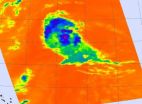(Press-News.org) Ancient pollen and charcoal preserved in deeply buried sediments in Egypt's Nile Delta document the region's ancient droughts and fires, including a huge drought 4,200 years ago associated with the demise of Egypt's Old Kingdom, the era known as the pyramid-building time.
"Humans have a long history of having to deal with climate change," said Christopher Bernhardt, a researcher with the U.S. Geological Survey. "Along with other research, this study geologically reveals that the evolution of societies is sometimes tied to climate variability at all scales – whether decadal or millennial."
Bernhardt conducted this research as part of his Ph.D. at the University of Pennsylvania, along with Benjamin Horton, an associate professor in Penn's Department of Earth and Environmental Science. Jean-Daniel Stanley at the Smithsonian Institution also participated in the study, published in July's edition of Geology.
"Even the mighty builders of the ancient pyramids more than 4,000 years ago fell victim when they were unable to respond to a changing climate," said USGS Director Marcia McNutt. "This study illustrates that water availability was the climate-change Achilles Heel then for Egypt, as it may well be now, for a planet topping seven billion thirsty people."
The researchers used pollen and charcoal preserved in a Nile Delta sediment core dating from 7,000 years ago to the present to help resolve the physical mechanisms underlying critical events in ancient Egyptian history.
They wanted to see if changes in pollen assemblages would reflect ancient Egyptian and Middle East droughts recorded in archaeological and historical records. The researchers also examined the presence and amount of charcoal because fire frequency often increases during times of drought, and fires are recorded as charcoal in the geological record. The scientists suspected that the proportion of wetland pollen would decline during times of drought and the amount of charcoal would increase.
And their suspicions were right.
Large decreases in the proportion of wetland pollen and increases in microscopic charcoal occurred in the core during four different times between 3,000 and 6,000 years ago. One of those events was the abrupt and global mega-drought of around 4,200 years ago, a drought that had serious societal repercussions, including famines, and which probably played a role in the end of Egypt's Old Kingdom and affected other Mediterranean cultures as well.
"Our pollen record appears very sensitive to the decrease in precipitation that occurred in the mega-drought of 4,200 years ago," Bernhardt said. "The vegetation response lasted much longer compared with other geologic proxy records of this drought, possibly indicating a sustained effect on delta and Nile basin vegetation."
Similarly, pollen and charcoal evidence recorded two other large droughts: one that occurred some 5,000 to 5,500 years ago and another that occurred around 3,000 years ago.
These events are also recorded in human history – the first one started some 5,000 years ago when the unification of Upper and Lower Egypt occurred and the Uruk Kingdom in modern Iraq collapsed. The second event, some 3,000 years ago, took place in the eastern Mediterranean and is associated with the fall of the Ugarit Kingdom and famines in the Babylonian and Syrian Kingdoms.
"The study geologically demonstrates that when deciphering past climates, pollen and other micro-organisms, such as charcoal, can augment or verify written or archaeological records – or they can serve as the record itself if other information doesn't exist or is not continuous," said Horton.
INFORMATION:This study, Nile delta response to Holocene climate variability, was published in the July edition of Geology, and was authored by Christopher Bernhardt, USGS; Benjamin Horton, Penn; and Jean-Daniel Stanley, Smithsonian Institution. Support for the work came from the University of Pennsylvania, the U.S. Geological Survey, and the Smithsonian Institution.
Photos for this release:
Visit: http://gallery.usgs.gov/tags/NR2012_08_16 for all available photos.
USGS provides science for a changing world. Visit USGS.gov, and follow us on Twitter @USGS and our other social media channels.
Subscribe to our news releases via e-mail, RSS or Twitter.
Links and contacts within this release are valid at the time of publication.
END
Lounging on a sofa while watching a 3D movie is an exquisite pleasure for many film fans. Be that as it may, those nettlesome 3D glasses might diminish the fun somewhat. That's why television manufacturers are working on displays that can recreate the spellbinding magic of three-dimensional television images – without the glasses. Though prototypes of these TV screens already exist, consumers will not have to wait much longer for the market introduction of these autostereoscopic displays. Neverthe-less, the content might be a bit problematic: The 3D movies currently available ...
Fairfax, Va.--The popular spice turmeric packs more than just flavor — it shows promise in fighting devastating viruses, Mason researchers recently discovered.
Curcumin, found in turmeric, stopped the potentially deadly Rift Valley Fever virus from multiplying in infected cells, says Aarthi Narayanan, lead investigator on the new study and a research assistant professor with Mason's National Center for Biodefense and Infectious Diseases.
Mosquito-borne Rift Valley Fever virus (RVF) is an acute, fever-causing virus that affects domestic animals such as cattle, sheep ...
Everyone knows the adage: "If something sounds too good to be true, then it probably is." Why, then, do some people fall for scams and why are older folks especially prone to being duped?
An answer, it seems, is because a specific area of the brain has deteriorated or is damaged, according to researchers at the University of Iowa. By examining patients with various forms of brain damage, the researchers report they've pinpointed the precise location in the human brain, called the ventromedial prefrontal cortex, that controls belief and doubt, and which explains why some ...
Ramadan dinners in the Danish Parliament, staff parties without either pork or alcohol and prayer rooms at the airport are all examples of how religion is becoming more visible in public spaces.
"Prior to the mass migration of the '60s, '70s and '80s, almost all Danes shared similar values and were members of the national Christian church, so religion was not an issue in everyday life. There was no need to discuss neither one's own nor another person's religious viewpoint, and secularisation was a matter of course. Today, it is difficult to be in a public place, read ...
VIDEO:
An animation of satellite observations from Aug. 13-16, 2012 shows the birth of the Atlantic Ocean hurricane season's eighth tropical depression that strengthens into Tropical Storm Gordon. This visualization was...
Click here for more information.
NASA has been watching the low pressure system called System 93L for the last week, and late on August 15 it organized into Tropical Depression 8, then Tropical Storm Gordon. NOAA's GOES-13 satellite captured a visible ...
Astronomers using data from NASA's Hubble Space Telescope have caught two clusters full of massive stars that may be in the early stages of merging. The clusters are 170,000 light-years away in the Large Magellanic Cloud, a small satellite galaxy to our Milky Way.
What at first was thought to be only one cluster in the core of the massive star-forming region 30 Doradus (also known as the Tarantula Nebula) has been found to be a composite of two clusters that differ in age by about one million years.
The entire 30 Doradus complex has been an active star-forming region ...
In the quest to understand how the world's weather moves around the globe, scientists have had to tease apart different kinds of atmospheric movement, such as the great jet streams that can move across a whole hemisphere versus more intricate, localized flows. Much the same must currently be done to understand the various motions at work in the great space weather system that links the sun and Earth as the sun shoots material out in all directions, creating its own version of a particle sea to fill up the solar system.
"People think of the sun as giving out light and ...
HOUSTON - A metabolic protein that nourishes cancer cells also activates tumor-promoting genes by loosening part of the packaging that entwines DNA to make up chromosomes, a team led by scientists at The University of Texas MD Anderson Cancer Center reports in the Aug. 16 issue of Cell.
Working in cell lines and mouse models of glioblastoma multiforme, the most lethal form of brain tumor, senior author Zhimin Lu, Ph.D., associate professor of Neuro-Oncology at MD Anderson, and colleagues show that pyruvate kinase M2 (PKM2) fuels tumor growth by influencing a histone protein.
DNA ...
PHILADELPHIA, August 16, 2012 – Without other risk factors, all Americans born between 1945 and 1965 should have a one-time screening for the hepatitis C virus (HCV) according to new recommendations being published early online today in Annals of Internal Medicine, the flagship journal of the American College of Physicians. The Centers for Disease Control and Prevention (CDC) also recommends that all persons identified with HCV should receive a brief alcohol screening and intervention and be referred to appropriate care and treatment services for HCV and related conditions.
Up ...
Thermafiber has officially announced the release of a new continuous insulation product. RainBarrier HD (Heavy Density) is a rigid insulation board with a consistent 6.0pcf density throughout the entire thickness. The consistent density from top to bottom simplifies installation by eliminating the need to orient the insulation in a certain direction like other mixed-density products. The increased density enhances the rigidity and ease of fabrication. The mineral wool board is non-combustible and provides exceptional R-values of 4.2 per inch of thickness. In addition to ...




